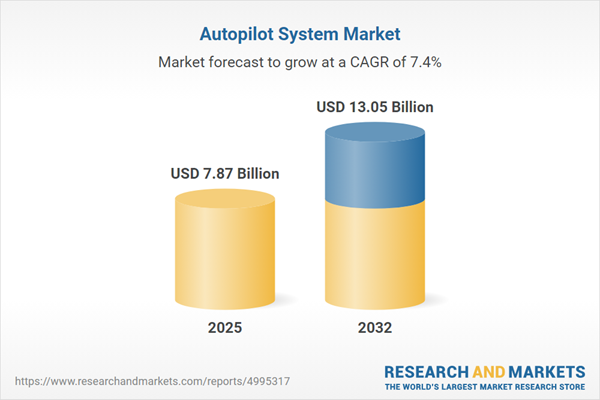Speak directly to the analyst to clarify any post sales queries you may have.
The Autopilot System Market is entering a transformative stage as global industries accelerate the integration of autonomous technologies across critical transportation sectors. Senior decision-makers face an evolving landscape where innovation and regulatory change are reshaping competitive dynamics and operational safety standards.
Market Snapshot: Autopilot System Market Growth and Outlook
The Autopilot System Market grew from USD 7.36 billion in 2024 to USD 7.87 billion in 2025. Driven by rising adoption across automotive, aviation, marine, and rail segments, the market is expected to expand at a compound annual growth rate (CAGR) of 7.41%, reaching USD 13.05 billion by 2032. This consistent growth trend reflects broad industry commitment to enhancing operational autonomy, safety, and efficiency in vehicle and vessel navigation.
Scope & Segmentation
- Component Types: Hardware (such as actuators, electronic control units, powertrain systems, sensors, and storage devices) and solutions including analytics platforms and management software.
- Autonomous Levels: Ranges from entry-level driver assistance to full automation, covering Level 1 through Level 5 systems across various modes of transport.
- Technologies: Incorporates global positioning systems (GPS), inertial measurement units (IMU), LiDAR (Light Detection & Ranging), and RADAR (Radio Detection & Ranging).
- Applications: Spans automotive (both passenger and commercial vehicles), aviation (commercial and military aircraft), marine (surface vehicles, ships, submarines), and rail systems.
- End-use Channels: Covers aftermarket and original equipment manufacturer (OEM) categories, reflecting diverse approaches to deployment and service delivery.
- Regional Coverage: Includes the Americas (United States, Canada, Mexico, and Latin America), Europe, Middle East & Africa (with major and emerging markets), and Asia-Pacific (featuring China, India, Japan, and other regional players).
- Key Companies: Features leading players such as Airbus SE, Tesla Inc., Honeywell International, Nvidia Corporation, The Boeing Company, and many others pivotal to market innovation and adoption.
Key Takeaways
- Rapid technological advancement is driving the evolution of autopilot systems, with artificial intelligence, machine vision, and sensor fusion enabling higher levels of automation.
- Collaboration between OEMs, component suppliers, and technology platform providers is accelerating the development and deployment of scalable, interoperable solutions.
- Regulatory frameworks are adapting, shaping performance benchmarks and certification pathways that impact new product launches, adoption timelines, and public trust.
- Adoption patterns vary significantly by region, with Asia-Pacific leading in investment momentum and urban mobility deployments, while the Americas focus on advanced driver assistance and Europe on stringent safety standards.
- End-use dynamics reflect increasing investment in modular architectures and over-the-air updates, supporting lifecycle improvements and ease of integration for operators.
Tariff Impact: Strategic Responses to Policy Change
Recent United States tariff measures have affected global supply chains, particularly for advanced sensors, control units, and software. These changes are prompting shifts in sourcing strategies, including near-shoring, localized manufacturing, and increased investments in vertical integration. Companies are also leveraging digital platforms to enhance supply chain visibility and resilience, offsetting some cost pressures and maintaining agility in a dynamic regulatory environment.
Methodology & Data Sources
This report is underpinned by a robust research methodology, combining interviews with industry executives, engineers, and regulators for primary insights. Secondary analysis integrates corporate filings, sector publications, and peer-reviewed studies. Advanced statistical validation, including scenario modeling and triangulation, supports high data fidelity and actionable findings for industry stakeholders.
Why This Report Matters
- Enables senior leaders to benchmark emerging trends and anticipate the strategic impact of evolving autopilot technologies across multiple transportation sectors.
- Delivers actionable intelligence on regulatory, supply chain, and innovation dynamics to inform investment, procurement, and partnership decisions.
- Supports tailored go-to-market and compliance strategies aligned with changing regional regulations and industry standards.
Conclusion
Autopilot systems are redefining operational paradigms across industries through technological progress, collaborative ecosystems, and adaptive regulatory strategies. Leaders equipped with these insights can proactively address challenges, seize new opportunities, and shape sustainable market positions.
Additional Product Information:
- Purchase of this report includes 1 year online access with quarterly updates.
- This report can be updated on request. Please contact our Customer Experience team using the Ask a Question widget on our website.
Table of Contents
3. Executive Summary
4. Market Overview
7. Cumulative Impact of Artificial Intelligence 2025
Companies Mentioned
The companies profiled in this Autopilot System market report include:- Airbus SE
- Anschütz GmbH
- Aurora Innovation Inc.
- Avidyne Corporation
- BAE Systems PLC
- Collins Aerospace by RTX Corporation
- ComNav Technology Ltd.
- DJI Technology Co., Ltd.
- Furuno Electric Co. Ltd.
- Garmin Ltd.
- Honeywell International, Inc.
- L3Harris Technologies, Inc.
- Lockheed Martin Corporation
- MicroPilot Inc.
- Moog Inc.
- Nvidia Corporation
- Raymarine by Teledyne Technologies Incorporated
- Robert Bosch GmbH
- Saab AB
- Safran S.A.
- Tesla Inc.
- Thales Group
- The Boeing Company
- TMQ International Pty Ltd
- UAV Navigation S.L. by Oesia Group
- Waymo LLC by Alphabet Inc.
- ZF Friedrichshafen AG
Table Information
| Report Attribute | Details |
|---|---|
| No. of Pages | 197 |
| Published | November 2025 |
| Forecast Period | 2025 - 2032 |
| Estimated Market Value ( USD | $ 7.87 Billion |
| Forecasted Market Value ( USD | $ 13.05 Billion |
| Compound Annual Growth Rate | 7.4% |
| Regions Covered | Global |
| No. of Companies Mentioned | 28 |









